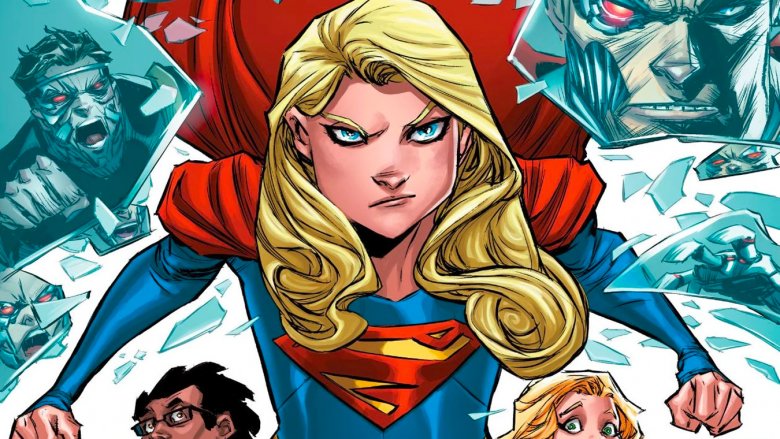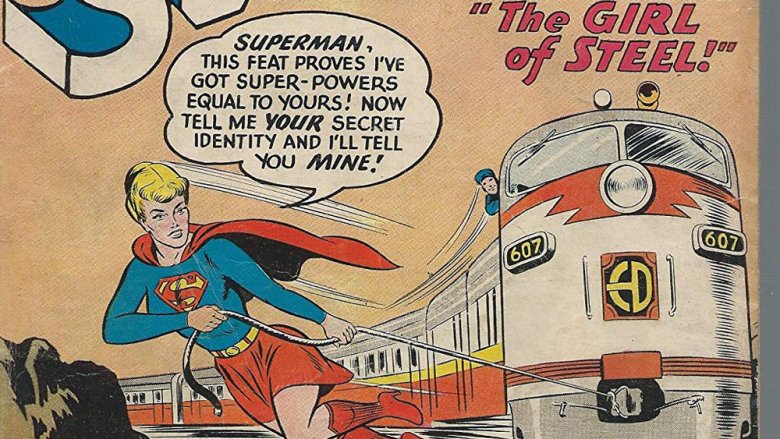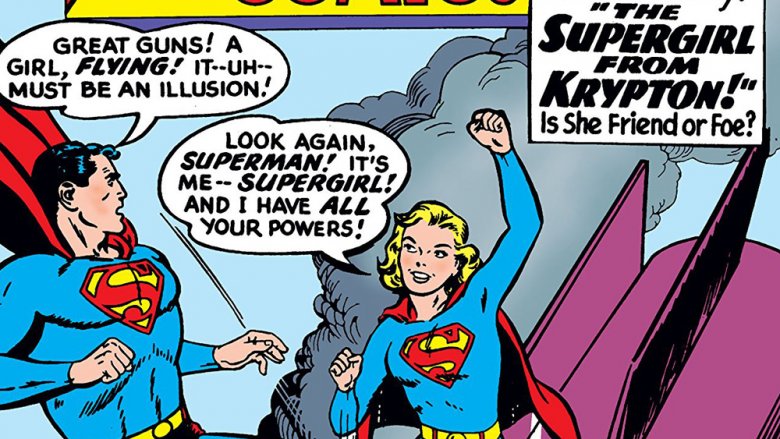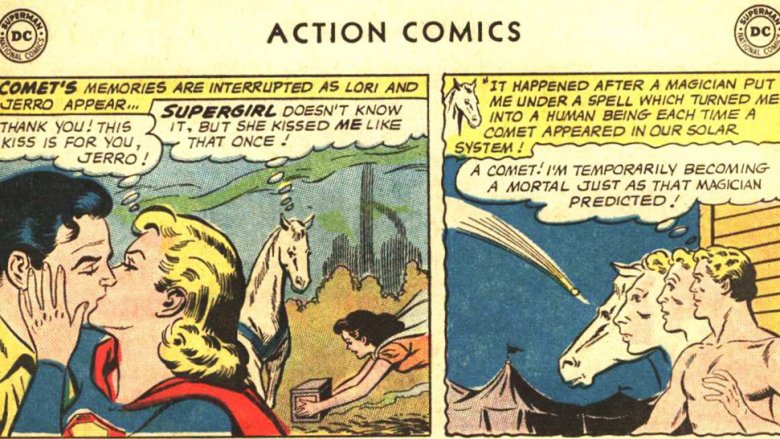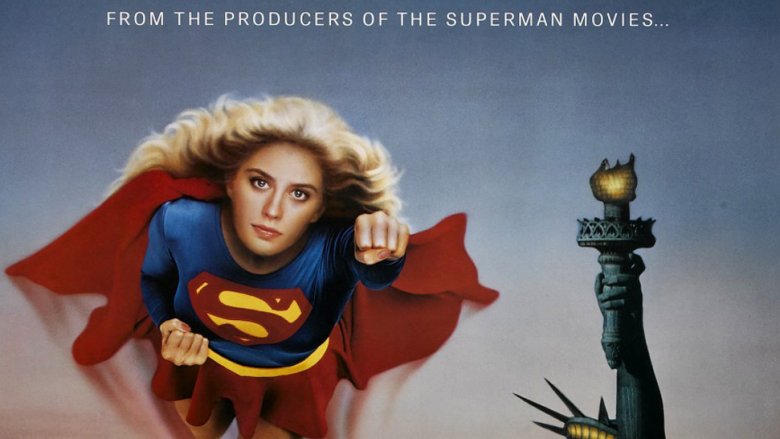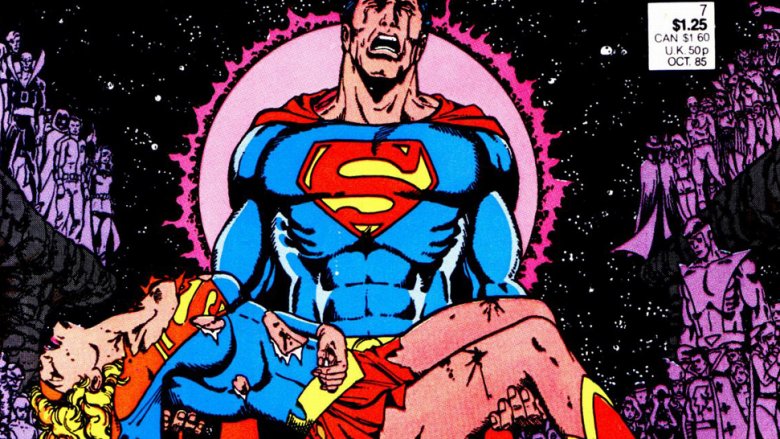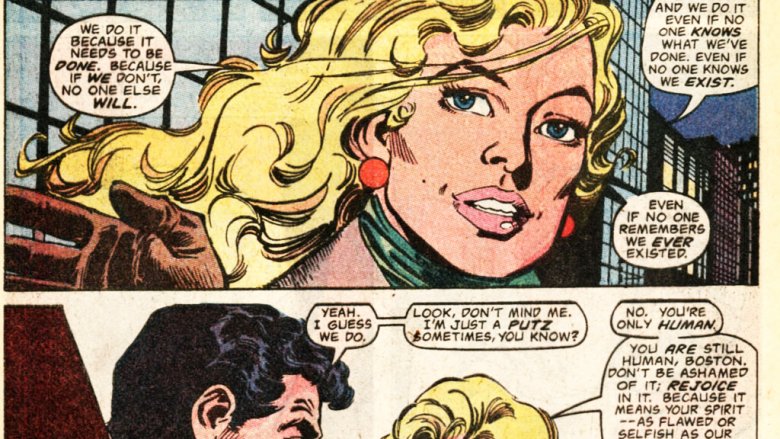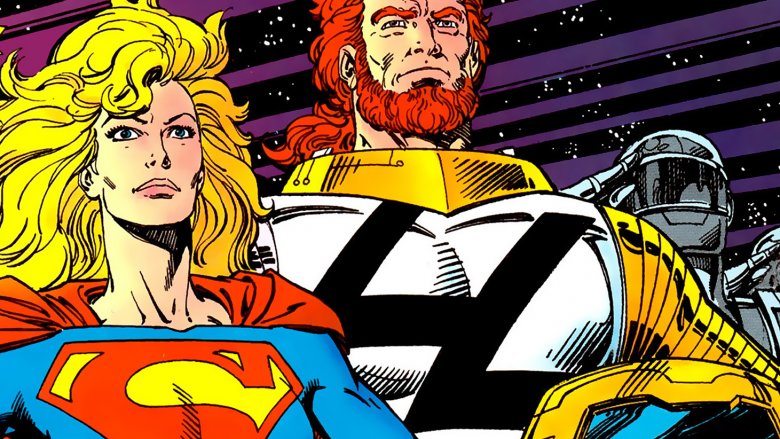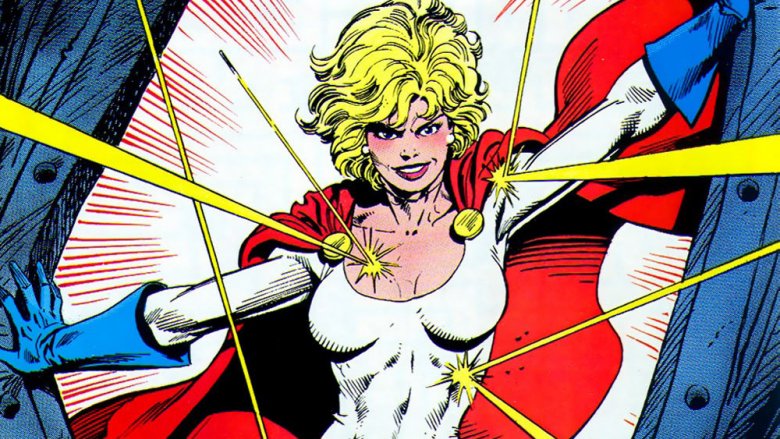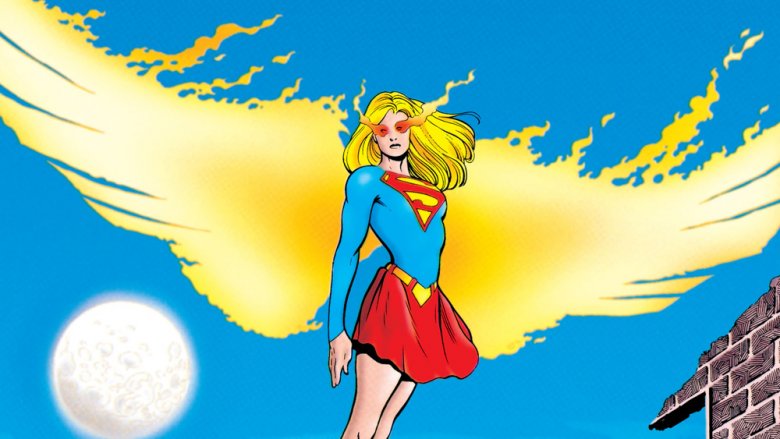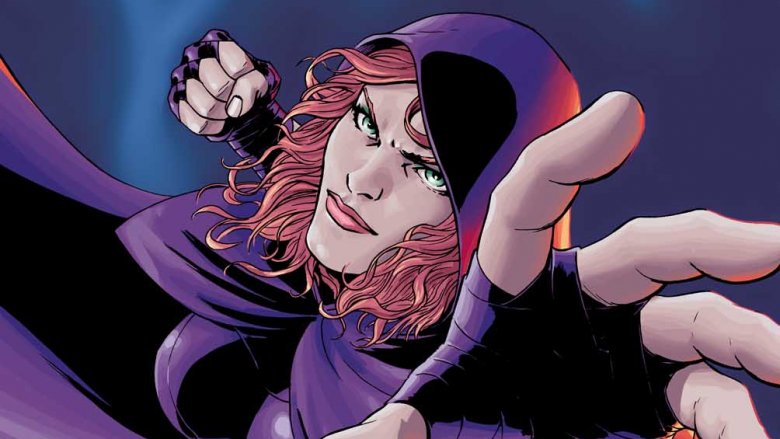Supergirl's Insane History
With multiple seasons of a TV show under her Kryptonian belt and a massive amount of merchandising filling up the toy aisles of your local stores, Supergirl is arguably more popular now than she's ever been, and that's saying something. Since she made her debut in 1959, her simple premise has made Superman's cousin Kara Zor-El has one of the most beloved characters in comics. Of course, that's only true if you ignore all the other stuff.
Like, say, how she kind of wasn't actually created in 1959, or those years when she wasn't Superman's cousin, or even Kryptonian, or how she dated a horse. Even by the standards of superhero comics, Supergirl's long history is a truly weird one. From her ill-fated romances to being obliterated from existence and replaced by a blob of protoplasm that used to sleep with Lex Luthor, here are the most unbelievably bizarre pieces of Supergirl's buck wild history.
The prototype
The single weirdest thing about Supergirl might be that she didn't show up for a full 20 years after the creation of Superman. With the immense popularity that the Man of Steel was enjoying when he showed up in 1938 and kicked off the superhero genre, it's more than fair to expect that a female take on the character would've been a part of the initial early '40s wave of imitators that brought us characters like Shazam, and even Batman. And yet, despite introducing Superboy ("the adventures of Superman when he was a boy!") in 1944 and Krypto the Superdog in 1955, DC Comics wouldn't get around to even attempting Supergirl for another three years. And yes: for those of you keeping score at home, that means the company greenlighted the idea of a superheroic dog before they were ready for a superheroic teenage girl.
When they finally did get around to this whole "Super-Girl" thing, she was originally introduced as a one-off character, and not only was this version not Superman's cousin, she actually died at the end of the story, and was never seen again. The first version — the one with the hyphen in her name — showed up in 1958's Superman #123, when Superman's Pal Jimmy Olsen found a magic genie belt and wished her into existence. After a few encounters in which she and Superman kept getting in each other's way, Super-Girl wound up exposing herself to Kryptonite and then begging Jimmy to end her hellish existence, which is a pretty dark twist ending for a Superman story from the '50s.
Despite her unfortunate end, this Super-Girl served as a prototype for the Girl of Steel that Otto Binder and Al Plastino would introduce the following year after readers responded well to the idea. Like Super-Girl, Kara's relative inexperience with her powers would be a frequent plot point, and visually, they were almost indistinguishable. Like Kara Zor-El, Super-Girl was blonde — perhaps to set her apart from Mary Marvel, the teenage girl take on Shazam that Binder had co-created in 1942 — and while Supergirl would swap out the prototype's red skirt for a blue one, Super-Girl's costume was not only similar to what readers would see, it's virtually identical to the one Melissa Benoist would wear on the Supergirl TV show almost 60 years later.
The Supergirl From Krypton!
In 1959, Action Comics #252 told the story of "The Supergirl From Krypton," and introduced readers to Supergirl for real. This time, it was Kara Zor-El, Superman's cousin whose family had survived the destruction of Krypton when their home, Argo City, was blasted into space as a single intact chunk of the planet. Unfortunately, the explosion turned Argo City into Kryptonite, poisoning the inhabitants and leading Zor-El to follow in his brother Jor-El's footsteps by packing his kid into a rocket and shooting her to Earth.
All things considered, that's a pretty plausible origin story by Superman standards. At the very least, it's more believable than "we had enough rockets for the whole family but the dog jumped into one and flew it into space," which is how we got Krypto. No, the weirdest part of the story is that Kara gets a pretty cold reception from her cousin. For two decades' worth of stories, Superman had believed himself to be the only survivor of his home planet, alone in the universe. Finally, he has a connection to Krypton, someone else who has lost her entire family and culture — a loss that undoubtedly affected her more because she grew up with it in a way that he didn't. At first, he's very welcoming, and the two really have that familiar connection... and then she asks if he can come live with him.
Here is Superman's literal response, quoted from the issue: "Hmm... No! That wouldn't work! You see, I've adopted a secret identity on Earth which might be jeopardized! But I have a great idea for your future life!" In other words, he doesn't want her cramping his style at his bachelor pad. Oh, and that great idea for her future? He gives her a wig and drops her off at an orphanage. No, really. That's how Superman deals with his only living relative in the universe.
That boy's a horse
By and large, Supergirl's adventures in the '50s and '60s tended to follow the same pattern as Superman's, at least at first. Her first major love interest, for instance, was Dick Malverne, a classmate who, like Lois Lane and Lana Lang before him, suspected Kara's secret identity and tried to trick her into revealing herself. The major difference? He was far less likeable about it, and more often than not, he lived up to his name.
As time went on, though, Supergirl's love life got truly weird. In addition to a long-running romance with a cyborg from the future and comic in which Superman felt compelled to inform her that marriage between first cousins was illegal on Krypton — which raises a lot of questions about the readers of those books — Supergirl's primary romantic interest was a horse. No, really. She straight up made out with Comet the Super-Horse on at least a couple of occasions.
Okay, admittedly, she didn't know he was a horse at the time, and it turned out that he hadn't always been a horse, but that knowledge doesn't actually make that story any better. See, Comet had actually been a centaur back in Hercules' time who, through a combination of helpful magic gone wrong, curses gone right, and an utter absence of logic, wound up living in space for a couple thousand years as a bulletproof flying horse who still had his (mostly) human brain. Whenever a specific comet came close to Earth, though, the magic would turn him fully human for a few days. So naturally, he kept all of this secret from Supergirl, assumed the human identity of ace rodeo rider "Bronco" Bill Starr, and dated Supergirl without ever telling her who he was. That all happened in 1963, and in the years since, no romantic relationship in comics has ever even gotten close to being that weird.
Supergirl: The Movie
As you might've heard, 1979 saw the release of Superman: The Movie, and, well, it was kind of a big deal. With Christopher Reeve's performance as the Man of Steel — not to mention the sweeping score by John Williams and an incredible marketing campaign with the unforgettable tagline "You will believe a man can fly" — audiences loved it, and launched DC's flagship character into a full-on franchise. By the mid-'80s and the release of Superman III, enthusiasm for the Superman films had waned a bit, but they were still successful enough to warrant a spinoff. Thus Supergirl, which attempted to recapture the magic and expand Superman's movie universe and... didn't quite make it.
While Helen Slater received a fair amount of praise in the title role, the movie itself was, to say the least, pretty weird. For one thing, while its version of Argo City had the same crystalline architecture that moviegoers had seen on Krypton, it had very little connection to the other Superman films. The only actor to appear in both was Marc McClure as Jimmy Olsen, without even a cameo from Reeve.
Even stranger was the plot. Rather than bringing in anything that had worked in the comics, the film instead pitted Supergirl against Faye Dunaway as an aspiring witch named Selena who got her hands on a Kryptonian artifact called the "Omegahedron" and tried to use it to summon demons. The only way it could've been more bizarre is if the filmmakers' original plan for casting had worked out. Country music legend Dolly Parton was offered the role of Selena, but turned it down over her reluctance to play a witch.
Still, Slater's wide-eyed earnestness in the part has its appeal, and her connection to the character has remained strong throughout the decades since, especially on television. Slater would go on to play Superman's mother, Lara, on Smallville, Supergirl's adopted mom Eliza Danvers on Supergirl, and even voiced Superman's other mom, Martha Kent, in an animated film.
A little less alive after 1985
In 1986, DC Comics launched an ambitious attempt to restructure their entire universe with a yearlong event called Crisis on Infinite Earths. The main idea was to eliminate some of the aspects that readers had come to regard as hokey and overcomplicated, condensing confusing timelines like Earth-1, Earth-2, Earth-S, and so on down to a single, streamlined universe. Whether they were actually successful with all that streamlining is up for debate, but we'll get back to that in a second.
Given that he had a longer and more convoluted history than anyone else on the DC Comics roster, it's not surprising that the Superman books went through the biggest overhaul. Along with recasting Lex Luthor as a deeply corrupt billionaire businessman, the big changes came in the form of a new origin for Clark Kent that re-established him as the true Last Son of Krypton, the only survivor of the planet's explosion, and eliminated the idea that he had his full powers before he was an adult. The end result? No Superboy, no Krypto the Superdog, absolutely no Comet the Super-Horse, and, in a fundamental change to the Superman mythos, no Supergirl.
The Ghost of Kara Zor-El
To give the character an ending rather than just writing her out of the books, Crisis on Infinite Earths #7 saw Kara sacrificing her life in order to save Superman and, with him, countless billions that were in danger in the story. The thing is, the way the effects of Crisis were resolved in the books, she wasn't a dead hero who was remembered in honor. Instead, in the new DC Universe, she'd simply never existed.
If that sounds like a downer, that's because it is, leaving more than a few fans upset about the treatment of the character, especially as compared to others who had suffered a similar fate. Barry Allen, the Flash, also died in Crisis an issue after Supergirl, but at least everyone remembered him. Alas, if only that movie the previous year had done a little better at the box office.
There was, however, an epilogue to Kara's story that cropped up in a pretty unexpected place. In 1989's Christmas with the Superheroes, a holiday anthology with a handful of stories, the ghostly Deadman lamented the fact that while he could briefly possess the living, he was in essence stealing those moments from other people, and leaving them with no memory of his heroic deeds. While he dealt with those feelings, a ghostly woman showed up and told him that heroism isn't done for recognition, but because they're the ones who can help when no one else can. "And we do it," she says, "even if no one knows what we've done. Even if no one knows we exist. Even if no one remembers we ever existed." In the final panels of the story, the woman gives her name as Kara, and while it didn't mean anything to Deadman, it meant a lot to the readers.
Enter: the Matrix
Crisis had done its level best to get rid of concepts like Superboy, Supergirl, and Krypto, but if you're familiar with superhero stories at all, it probably won't surprise you to learn that literally all of it eventually came back. Even putting aside the nostalgia that a new generation of creators had for their favorites, copyrights on characters like Supergirl are very valuable, and if they're not being used, they can fall out of the control of the companies that own them. It's no surprise, then, that Supergirl found her way back to the page. The fact that she did it in less than two years, however, is pretty surprising, especially when you find out how it all went down.
To be fair, this wasn't Kara Zor-El. Instead, this Supergirl was a shape-shifting "protoplasmic matrix" created in an alternate pocket dimension by a good Lex Luthor, who made her look like his dead ex-girlfriend and gave her all of Superman's powers plus turning invisible. She then came to the regular DC Earth and moved in with Superman's parents, who called her "Mae" — short for "Matrix" — and she became the new Supergirl. She then moved in with Lex Luthor II, who was actually regular Lex Luthor (the evil one) who had transplanted his brain into a clone body and told everyone that he was his own son, which they bought because he was speaking with an Australian accent, and who later made a bunch of clones of Matrix for what we can only assume were extremely unsavory purposes. A few years later, she symbiotically bonded with a dead teenager and split into a good Matrix and an evil Matrix, and might have also been an angel. Like, a literal angel. From Heaven.
Good thing we had that Crisis thing, huh? This new stuff was way easier for new readers to understand than "she's Superman's cousin."
Who is Power Girl?
If you think the post-Crisis Supergirl was complicated, hold onto your butts, folks, because we're about to talk about Power Girl. Right from the start, she's a little more complicated, but the short version is that before Crisis, DC's multiverse contained a dimension called Earth-2 where they stuck all the characters from the '40s who had been rebooted in the '50s and '60s. Whenever they showed up, they were always presented as being a decade or two older than their mainstream "Earth-1" counterparts, giving a home to characters like the original Flash and Green Lantern, and even the "original" Superman, who had a slightly different logo and couldn't quite fly.
He still had a cousin on that Earth, though, but Earth-2's Kara Zor-L — who, like her cousin, was distinguished from Earth-1's Kara Zor-El by the slight name change — didn't go by Supergirl. Instead, this older version went by Power Girl, with a completely different costume. For some reason, Power Girl was considered to be more necessary for the post-Crisis DC Universe, and managed to stick around once the universe was streamlined, and even spent some time in the Justice League in the late '80s.
The thing is, Power Girl was an alternate version of a character who no longer existed, from a universe that no longer existed, whose entire reason for being had been completely eliminated. The post-Crisis Power Girl could no longer be Superman's cousin, and creators spent the next 20 years trying to figure out what her deal was. The first big solution was that she was actually the granddaughter of a wizard from the lost continent of Atlantis who put her in a magic crystal for 45,000 years. Then she got magic pregnant and gave birth to a magic rapidly-aging baby who was never seen again. Then she was a major character in a team book that, when it got canceled, was revealed to have been a fantasy drawn in a child's coloring book. Then she was just Superman's cousin again. Comics!
Angels we have heard on... fire?
Right, the angel thing. If the concept of Matrix-Supergirl wasn't weird enough, 1996 saw the launch of a new Supergirl series, in which Supergirl gained a new secret identity. This time, it was Linda Danvers, a young woman who had unfortunately been kidnapped and sacrificed to the devil before her first comic ever even started. Matrix found her body and, overwhelmed with grief, bonded with her, merging her protoplasmic form and personality with Linda's, becoming a new Supergirl in the process. So far, that's relatively simple by Supergirl standards.
A few years into the run, however, Supergirl spontaneously developed the ability to sprout fiery wings, and the book began to feature Wallace Johnson, a.k.a. Wally the God-Boy, a boy who claimed he was God. It eventually turned out that Linda was an "Earth-born angel," and that bonding with Matrix's super-powered protoplasm had allowed her human form to contain this divine essence far longer than it would've otherwise.
At this point, Supergirl was an angel who was also a teenage devil worshipper who was also a blob from another dimension, who was also somehow still connected to Superman. It won't surprise you to learn that after a few years of this, they got rid of Supergirl and introduced another one who was... Superman's cousin from Krypton. Weird how that works out.
Definitely not not not not not not Supergirl
While the saga of protoplasmic teenage angel Supergirl is truly bizarre, perhaps the weirdest part of it has a lot more to do with what happened behind the scenes than what happened on the page.
After the Linda Danvers Supergirl title was canceled, the writer, Peter David, launched another series with artist David Lopez called Fallen Angel. Over the course of the run, there were several hints — which were encouraged by David — that the main character could really be Linda Danvers, who was now living in Louisiana and hanging out at a bar that was heavily implied to be owned by Adolf Hitler, alive and living in secret in 2005. What makes it even weirder is that while the book was originally published by DC, David and Lopez later moved it to another publisher, IDW, since despite all the blatant hints, "Liandra" was a legally distinct creator-owned character who was definitely not Linda, as far as the rights were concerned. That's even weirder than the time there were four Supergirls running around at the same time, or when Comet came back and was a secret woman instead of being a secret horse, or when Supergirl couldn't join the Legion because she got turned into an adult by space radiation for ten minutes, or... well, you get the idea.
